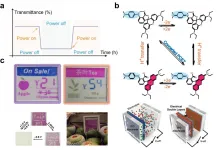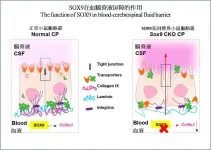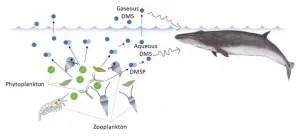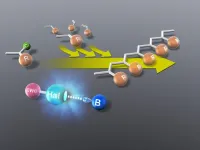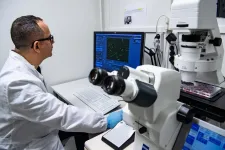INFORMATION:
Green revolution in electronic displays expected to ease energy and health crises
2021-02-24
(Press-News.org) The development of low-energy-consumption and user-friendly electronic displays has become a long-term goal for future global sustainable development. Bistable electronic display, which requires very little electric drive to turn pages without consuming additional power to continuously display information/images, is one of the very good potential alternatives. Reflective display technologies with partial/complete bistable characteristics include e-ink, cholesteric liquid crystal, and electrochromic technologies, etc. They display information in light reflection mode, which can still be read under high-brightness outdoor sunlight and relatively dark indoor environments. It is also very friendly to the eyes, and can effectively avoid the damage to the eyes caused by the glare of traditional light-emitting display directly hitting the retina. In contrast, the bistable electrochromic materials and devices have attracted increasing attention all over the world due to their exciting advantages (such as, bright colors, wide color variation range and relatively easy preparation process, etc).
In a new paper published in Light Science & Application, a team of scientists, led by Professor Sean Xiao-An Zhang from State Key Laboratory of Supramolecular Structure and Materials, College of Chemistry, Jilin University, China, summarized new strategies to achieve more ideal bistable electrochromic systems.
Currently, various electrochromic materials have been exploited, and different bistable materials design and performance optimization strategies have been proposed, such as, the color and transmittance of the device can be changed through reversible deposition and dissolution of metal ions on the electrode surface to achieve bistable electrochromic display; the HOMO level of the redox polymer is regulated by modifying the substituent on the conjugate polymer's skeleton, thus affecting the interface charge transfer between the polymer and the electrode, and inhibiting the spontaneous redox reaction; the bistable performance of the material can be optimized by mixing different molecules together (such as, with the structural stability of the selenium-containing polymer and the good optical properties of the thiophene polymer in the visible region); exploit indirect EC system with a new mechanism---"regulatable electro-acid/base"-induced reversible molecular color switches. It is an effective way to overcome the insurmountable technical bottleneck of traditional direct EC systems by avoiding unstable free radicals during the reaction via collaborative interactions/stabilization, and has been widely used to overcome undesirable high-energy-state/-barriers of redox molecules for various chemical reactions.
Although the bistable displays technologies have shown super-power-saving performance. It has been long-expected to enter the market as a key technology and promote the "green and sustainable development" of global society. But they are currently competing mainly at the lower end of the market. The reason is that parts of their performance (such as the speed of turning pages and the color quality/brightness) are not yet comparable to the products of the mainstream light-emitting display. Therefore, there are two ways to enable the long-awaited green electronic displays to truly meet human needs for high-quality visual experience and low energy consumption, and make them popular in the mainstream market quickly. One of the solutions is to optimize the comprehensive performance of the bistable light-absorbing electronic display so that it can meet the actual requirements of high-end displays as soon as possible. However, as mentioned above, there are many very difficult technical obstacles in this path. First, the photodegradation and oxygen sensitivity of organic materials need to be overcome. We need to go beyond traditional thinking and technological frameworks to solve this problem. Regarding the protection of dye molecules from ultraviolet light, in addition to using traditional packaging materials to absorb and block light, we can explore whether ultraviolet light can be effectively converted into visible light by using small molecules or oligomers in the EC layer or packaging materials. That is, whether such energy conversion can further enhance the color brightness of EC displays. Secondly, strategies and materials for achieving more universal panchromatic tunability remain to be further developed. Thirdly, the in-depth study of electrochromic mechanism and dynamics of existing systems are not enough. For example, the synergies in PCET reactions, the dynamic processes of electrons and ions in inorganic/organic EC reactions, the electron transfer between the electrodes and the EC materials, and other processes involved in EC reactions all require further understanding and precise optimization. Fourth, the structure of the device needs further optimized, such as the construction of a conductive layer material with controllable ion transmission, the reference of electron/hole transmission material in OLED devices, the improvement of electron transmission between the active substance and the electrode via realization of nano-scale three-dimensional electrode. We should learn in depth from nature, explore the possibility of man-made "nerve networks" systems via structural design, synthesis and molecular self-assembly and attempt to use bionic "nerve networks" to replace the current method of electrolyte diffusion for quick transfer of electrons and charges in the system.
Another solution is to revolutionize the mainstream light-emitting displays by exploiting their bistable properties. To realize this seemingly "impossible" dream, it is obvious that revolutionary technologies will need to be combined with new display mechanism design and device structure optimization. We can also adopt strategies of cross-fusing mainstream and emerging display technologies with other existing technologies (such as electrofluorescence, electrophosphorescence, controllable delay (or long-lived) electroluminescence, and indirect EC molecular switching) to give more ideal performances for future display. Integrating a variety of known or new display technologies could provide a more promising strategy and product development to satisfy various human needs, such as EC-LED/OLED dual mode systems for all-weather ultra-power-saving display technology.
"History of human development shows that the driving force behind scientific and social progress is the spirit of questioning and challenging. Many seemingly "unsolvable" problems are gradually resolved by further understanding the cause of the problem through the collaboration of science and technology workers."
"Hopefully, this paper can allow an increasing number of researchers to understand the above scientific and technological challenges and their significance, trigger global cooperation to challenge the "impossible" scientifically forbidden zone and bring innovation in green technology to a new level." they added.
ELSE PRESS RELEASES FROM THIS DATE:
Using landscape connectivity to control deadly mosquito-borne viruses
2021-02-24
The yellow fever mosquito (Aedes aegypti) is a main vector of deadly diseases like dengue fever, chikungunya, and the Zika virus, which result in hundreds of thousands of deaths worldwide each year. Because Ae. aegypti prefers to bite humans and there are no vaccines for many of these diseases they carry, developing methods to control these insects is imperative in the fight to control illness.
In a study recently published in Proceedings of the National Academy of Sciences, a Yale-led research team developed a new method to track how Ae. aegypti move through the environment. ...
3D holographic microscopy powered by deep-learning deciphers cancer immunotherapy
2021-02-24
Live tracking and analyzing of the dynamics of chimeric antigen receptor (CAR) T-cells targeting cancer cells can open new avenues for the development of cancer immunotherapy. However, imaging via conventional microscopy approaches can result in cellular damage, and assessments of cell-to-cell interactions are extremely difficult and labor-intensive. When researchers applied deep learning and 3D holographic microscopy to the task, however, they not only avoided these difficultues but found that AI was better at it than humans were.
Artificial intelligence (AI) is helping researchers decipher images from a new holographic microscopy technique needed to investigate ...
CUHK study brings new direction for treating neurological diseases
2021-02-24
The finding, recently published in the prestigious scientific journal Proceedings of the National Academy of Sciences of the United States of America (PNAS), has provided the scientific community a novel understanding to the molecular regulatory mechanisms behind the function of the blood-CSF barrier and lays the groundwork for developing novel therapeutic strategies for preventing and treating neurodevelopmental disorders.
Dysfunction of blood-cerebrospinal fluid barrier is common in various neurological diseases
CSF is a clear, colourless body fluid that surrounds the brain and spinal cord, providing them a cushion against injuries. It also ...
Historical document details martyrdom of Japanese Christian retainers 400 years ago
2021-02-24
In Japan, the suppression of Christianity increased from the end of the 16th century to the beginning of the 17th century, and many missionaries and Japanese believers were martyred during this period. New research has uncovered a letter indicating that Hosokawa Tadaoki, lord of the Kokura domain from 1600 to 1620, ordered the execution of Diego Hayato Kagayama, a chief vassal of the Hosokawa family, and the banishment of Genya Ogasawara, both Christians. The punishment and martyrdom of both men was previously known only from reports by Jesuit missionaries to Rome. The discovery of primary historical documents created within the Hosokawa ...
Recent progress in heterogeneous III-V-on-silicon photonic integration
2021-02-24
Integrated photonics was rejuvenated as Si starting challenging the dominant position of conventional III-V compound semiconductors at onset of the new millennium. Heterogeneous Si photonics utilizes wafer bonding to transfer functioning non-Si thin film onto Si substrate to make up missing or weak optoelectronic functionalities of Si material. In the past 15 years, it has evolved into a broad technology with many branches as shown in Fig. 1. As the most mature one among them, heterogeneous III-V-on-silicon integration provides an ideal platform to marry their respective material and production advantages. Two veteran researchers in this field, Dr. Di Liang from Hewlett Packard Labs and Prof. ...
Follow the smell of the ocean to find where marine predators feed
2021-02-24
A joint research project between organizations in Japan and the US has demonstrated that zooplankton, a major food source for marine predators, can be located by following the concentration gradient of the chemical dimethyl sulfide (DMS) in ocean water and air. Currently, little is known about how marine predators search for and find enough food to maintain their body size. This study is expected to expand research into the chemical triggers of marine organisms while foraging.
Zooplankton, such as krill and copepods are the main energy source for many large marine animals. The big predators must consume a large amount of these tiny creatures to provide ...
Southern California COVID-19 strain rapidly expands global reach
2021-02-24
LOS ANGELES (Feb. 11, 2021) -- A new strain of the coronavirus in Southern California, first reported last month by Cedars-Sinai, is rapidly spreading across the country and around the world as travelers apparently carry the virus with them to a growing list of global destinations, according to new research published today in the peer-reviewed Journal of the American Medical Association (JAMA).
The strain, known as CAL.20C, was first observed in July 2020 in a single Los Angeles County case, as Cedars-Sinai earlier reported. It reemerged in October in Southern California and then quickly END ...
Fabricating the future with a new environment friendly method of polymerization
2021-02-24
Many materials in the modern world--from the plastics that dominate it to the electronic chips that drive it--are constructed of polymers. Given their ubiquity and the evolving requirements of our world, finding better and more efficient methods of making them is an ongoing research concern. In addition, current environmental issues necessitate the use of methods and input materials that are environment friendly.
Recent research by scientists from Nagoya Institute of Technology, Japan, has been in this vein, adding a new twist to a polymerization technique that has been around and successful since the 1980s: living cationic polymerization, where the polymer chain growth does not have the ability to terminate until the monomer is consumed. The scientists have, for the first ...
New fossil discovery illuminates the lives of the earliest primates
2021-02-24
New York, February 24, 2021 - Graduate Center, CUNY/Brooklyn College professor was part of a discovery of the first fossil evidence of any primate, illustrating the earliest steps of primates 66 million years ago following the mass extinction that wiped out all dinosaurs and led to the rise of mammals.
Stephen Chester, an assistant professor of anthropology and paleontologist at the Graduate Center, CUNY and Brooklyn College, was part of a team of 10 researchers from across the United States who analyzed several fossils of Purgatorius, the oldest genus in a group of the earliest-known primates called plesiadapiforms. ...
Many genes associated with the risk of coronary artery disease act through the liver
2021-02-24
According to a new study published in The American Journal of Human Genetics, more than one third of genetic variants that increase the risk of coronary artery disease regulate the expression of genes in the liver. These variants have an impact on the expression of genes regulating cholesterol metabolism, among other things. The findings provide valuable new insight into the genetics of coronary artery disease. The study was conducted in collaboration between the University of Eastern Finland, Kuopio University Hospital, the University of California Los Angeles, and the University of Arizona.
Coronary artery disease (CAD) and its most important complication ...
